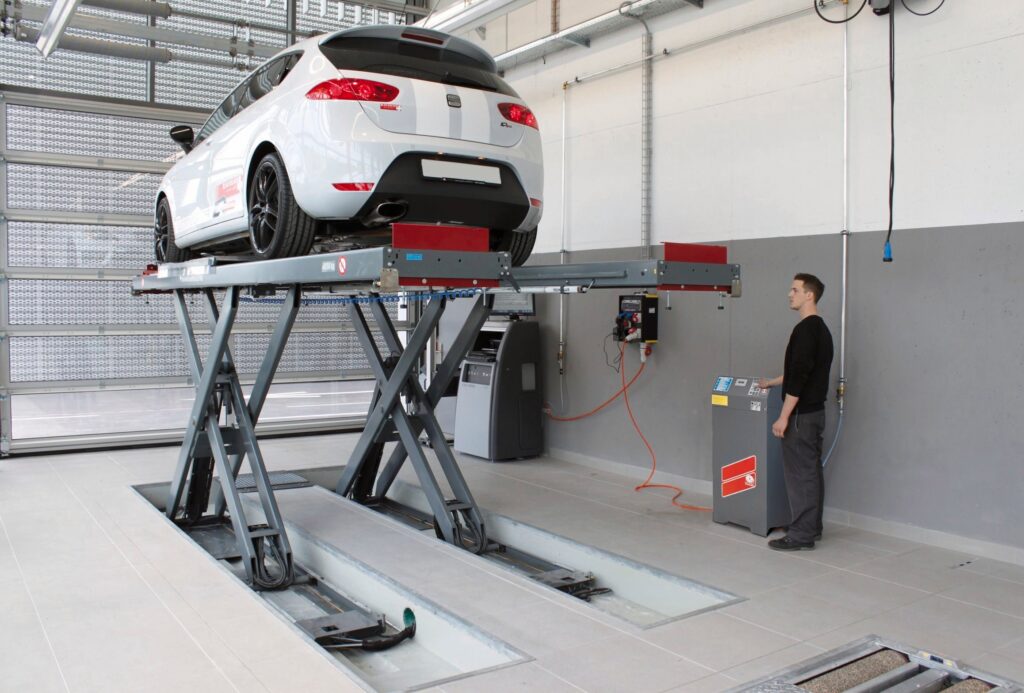
Low profile car lifts are a popular choice for car enthusiasts and professional mechanics. These lifts are designed to help you easily lift vehicles that have a low ground clearance. But many people often ask: Are low profile car lifts compatible with all vehicle types? In this article, we will dive into the compatibility of low profile car lifts with different vehicle types, their advantages, and the factors that influence their compatibility. We will also explore why Coats Company offers high-quality low profile car lifts that can suit various vehicle needs.
What Are Low Profile Car Lifts?
Before we answer the compatibility question, let’s first understand what low profile car lifts are. These lifts are designed for vehicles that sit closer to the ground. They have a lower height and are specifically built to lift cars and trucks that may not fit on regular lifts due to their low ground clearance. Low profile car lifts use hydraulic systems to lift the vehicle and are commonly used in both home garages and professional workshops.
Key Features of Low Profile Car Lifts:
-
Low height: Perfect for vehicles with minimal ground clearance.
-
Compact design: Takes up less space in your garage or workshop.
-
Ease of use: Simple operation for lifting and lowering vehicles.
Are Low Profile Car Lifts Compatible with All Vehicle Types?
Low profile car lifts are not universally compatible with every vehicle. While these lifts are designed to accommodate cars with lower ground clearance, certain vehicles may require additional considerations to ensure a safe and effective lifting process. Let’s explore the factors that determine compatibility.
1. Vehicle Ground Clearance
One of the most important factors in determining whether a low profile car lift is compatible with your vehicle is the ground clearance. Vehicles like sports cars, sedans, and some compact cars typically have lower ground clearance, making them ideal candidates for low profile lifts. However, higher ground clearance vehicles, such as trucks, SUVs, or lifted cars, may not fit well on a low profile lift. For these types of vehicles, a standard lift with a higher lifting height may be more suitable.
2. Weight of the Vehicle
Another factor to consider is the weight of the vehicle. Low profile car lifts are designed to handle certain weight limits, typically between 6,000 to 10,000 pounds. If your vehicle exceeds this weight, you should carefully check the lifting capacity of the lift before use. Always follow the manufacturer’s weight recommendations to avoid damaging the lift or causing unsafe conditions.
3. Size and Dimensions of the Vehicle
The size of the vehicle can also play a role in compatibility. While low profile lifts work well for smaller vehicles, larger vehicles, such as full-sized trucks or vans, may be more difficult to lift with this equipment. Be sure to measure the length and width of your vehicle to ensure it can be securely placed on the lift.
4. Vehicle Design and Construction
The design of the vehicle, especially the chassis and undercarriage, is another consideration when determining compatibility. Some vehicles have unique undercarriages or side skirts that could interfere with the lift. If the undercarriage is too low or has specific components, such as low-hanging exhausts, this could make the vehicle unsuitable for use on a low profile lift.
Benefits of Using Low Profile Car Lifts
While low profile car lifts may not be compatible with all vehicle types, they offer many benefits for those who need them. Here are some of the advantages of using low profile car lifts for compatible vehicles:
1. Space-Saving Design
Low profile car lifts are compact and ideal for smaller spaces. They don’t take up much room in your garage, making them a great option for people with limited space.
2. Improved Accessibility
These lifts provide easy access to the underside of the vehicle, making it easier to perform repairs such as oil changes, brake repairs, and tire rotations.
3. Ease of Use
Low profile car lifts are simple to use. They are often easier to operate than other types of lifts, providing a smooth and hassle-free lifting experience.
4. Quick Setup
Setting up a low profile lift typically takes less time compared to other lifts, allowing you to begin your repair work faster.
How to Choose the Right Low Profile Car Lift for Your Vehicle
Now that we know the factors that influence compatibility, let’s explore how to choose the right low profile car lift for your vehicle.
1. Check the Vehicle Specifications
Start by checking your vehicle’s ground clearance, weight, and dimensions. Most manufacturers will provide this information in the vehicle manual or on their website. Comparing these measurements to the specifications of the lift will help you choose the right model.
2. Understand the Lift’s Capacity
Make sure that the low profile lift you select has the lifting capacity to handle the weight of your vehicle. Overloading the lift can be dangerous and may damage both the lift and your vehicle.
3. Select a Reliable Brand
Choosing a reputable brand, like Coats Company, ensures that the lift is made with high-quality materials and safety features. Well-known brands follow safety standards and regulations, which provide additional peace of mind.
4. Consult with Experts
If you are unsure about the compatibility of your vehicle with a low profile car lift, it is always a good idea to consult with a professional. Coats Company can help guide you in selecting the best low profile lift for your specific needs.
Conclusion
Low profile car lifts are an excellent tool for lifting cars and vehicles with low ground clearance. However, they are not suitable for every vehicle. When choosing a low profile car lift, it’s important to consider the ground clearance, weight, size, and undercarriage of your vehicle. If your car is compatible, a low profile car lift can provide benefits such as space-saving, improved accessibility, and ease of use.
For those looking for high-quality low profile car lifts, Coats Company offers a range of reliable, durable options that are designed to meet various vehicle needs. Always choose a lift that is compatible with your vehicle to ensure safety and optimal performance.





